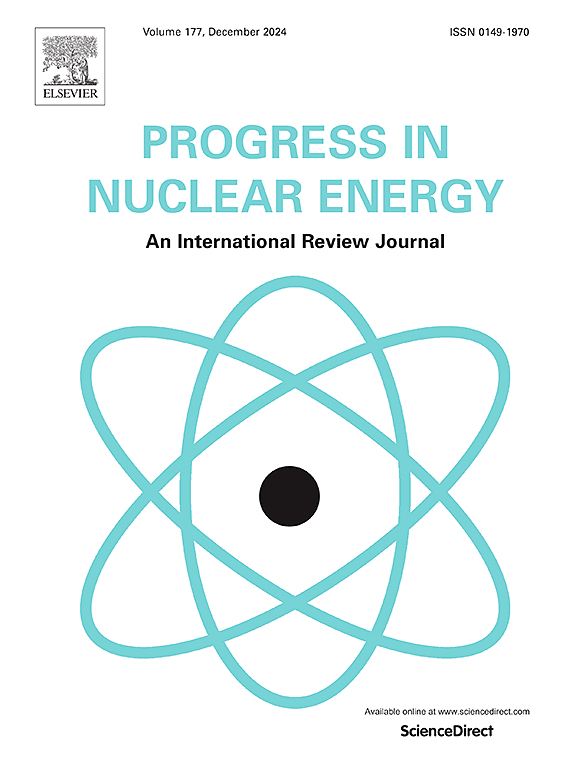印度PHWR包层在1000 ~ 1500℃蒸汽氧化过程中氧化物和α-Zr(O)生长动力学研究
IF 3.3
3区 工程技术
Q1 NUCLEAR SCIENCE & TECHNOLOGY
引用次数: 0
摘要
研究了印度重水堆(IPHWRs)包层(Zircaloy-4)在1000 ~ 1500℃温度范围内的等温蒸汽氧化。建立了高温蒸汽氧化过程中形成的固有脆性相氧化物和氧稳定α-Zr的生长动力学。在单面氧化的情况下,在α-Zr(O)的下方,或者在包层内外两层α-Zr(O)之间,有一种被称为优先β-Zr的延展性相,它控制着包层的脆化程度。β-Zr的厚度由氧化物和氧稳定α-Zr的生长速率决定。动力学速率常数Kp (cm2/sec)服从抛物线速率方程。氧化垢和α-Zr(O)层生长的抛物线速率常数Arrhenius表达式与其他研究者建立的表达式比较好。利用内部氧化模型OXYCON对氧化层和α-Zr(O)层厚度的实验数据进行了评价。该模型对α-Zr(O)氧化层厚度预测不足,对α-Zr(O)氧化层厚度预测过高。然而,利用本研究建立的动力学方程对国产锆-4包层的氧化物、α-Zr(O)和总氧化物+α-Zr(O)的预测有了很大的提高。因此,还可以进一步准确地预测β-Zr层的先验厚度。本文章由计算机程序翻译,如有差异,请以英文原文为准。
Study of oxide and α-Zr(O) growth kinetics in the temperature range 1000–1500 °C during steam oxidation of Indian PHWR cladding
Isothermal steam oxidation of Indian pressurized heavy water reactors (IPHWRs) cladding (Zircaloy-4) has been studied in the temperature range of 1000–1500 °C. Growth kinetics of inherently brittle phases, oxide and oxygen stabilized α-Zr, developed during the high temperature steam oxidation were established. A ductile phase known as prior β-Zr, lying either underneath the α-Zr(O), in case of a single sided oxidation, or in between two layers of α-Zr(O) at the inner and the outer surface of the clad, governs the extent of embrittlement of the clad. Thickness of prior β-Zr is decided by the rate of growth of oxide and oxygen stabilized α-Zr. The kinetic rate constant Kp (cm2/sec) obeyed a parabolic rate equation. The Arrhenius expression of parabolic rate constants for oxide scale and α-Zr(O) layer growth compares well with those established by other investigators. An in-house oxidation model, OXYCON was evaluated against the experimental data of oxide and α-Zr(O) layer thickness. The model under-predicted the oxide layer thickness and over-predicted the α-Zr(O) layer thickness in its existing form. However the prediction of oxide, α-Zr (O) and total oxide+α-Zr(O) improved to a significant extent by using kinetic equations derived in the present study done on the indigenously fabricated Zircaloy-4 cladding. Hence, successively the prediction of the prior β-Zr layer thickness could also be done with further accuracy.
求助全文
通过发布文献求助,成功后即可免费获取论文全文。
去求助
来源期刊

Progress in Nuclear Energy
工程技术-核科学技术
CiteScore
5.30
自引率
14.80%
发文量
331
审稿时长
3.5 months
期刊介绍:
Progress in Nuclear Energy is an international review journal covering all aspects of nuclear science and engineering. In keeping with the maturity of nuclear power, articles on safety, siting and environmental problems are encouraged, as are those associated with economics and fuel management. However, basic physics and engineering will remain an important aspect of the editorial policy. Articles published are either of a review nature or present new material in more depth. They are aimed at researchers and technically-oriented managers working in the nuclear energy field.
Please note the following:
1) PNE seeks high quality research papers which are medium to long in length. Short research papers should be submitted to the journal Annals in Nuclear Energy.
2) PNE reserves the right to reject papers which are based solely on routine application of computer codes used to produce reactor designs or explain existing reactor phenomena. Such papers, although worthy, are best left as laboratory reports whereas Progress in Nuclear Energy seeks papers of originality, which are archival in nature, in the fields of mathematical and experimental nuclear technology, including fission, fusion (blanket physics, radiation damage), safety, materials aspects, economics, etc.
3) Review papers, which may occasionally be invited, are particularly sought by the journal in these fields.
 求助内容:
求助内容: 应助结果提醒方式:
应助结果提醒方式:


